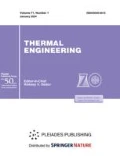Abstract
Taking into account new problems arising in the transportation of a steam-water heat carrier to support operation of geothermal power plants (GeoPP), a procedure is outlined for determining the void fraction considering the gravity component of the pressure drop in the hydraulic design calculations of steam-water piping. Unavailability of data on the void fraction under the conditions of geothermal heat carrier transportation is noted. The drift flux model determining the steam velocity averaged over the channel cross-section was used to solve the formulated problem for upward flows. The factors affecting the distribution parameter and the drift velocity are reviewed. It is noted that the drift velocity depends not only on the gravity force but also on the hydrodynamic effect, which can be taken into account using the advanced distribution parameter. A similar approach has been proposed for downward flows according to which the liquid phase velocity averaged over the channel cross-section is calculated using equivalents of the empirical coefficients determined from the condition of equality of the parameters calculated for the upward and downward flows as applicable to the horizontal flow. The empirical values included in the recommended calculation formulas have been established. The proposed recommendations have been used in developing a computer code for the hydraulic design of pipelines. In addition to the gravitational pressure drop, the code also calculates the pressure drop due to friction or local resistance using formulas, which offers good agreement with the experimental data. To verify the model used in the program for the calculation of the gravitational pressure drop, the predictions were compared with the experimental data of the pressure drop across the pipeline from the Geo-1 well to the Verkhne-Mutnovskaya GeoPP (Kamchatka), which is in operation and features the maximum height difference among all existing domestic pipelines carrying steam-water mixture. A good agreement was found between the predictions and the experimental data on pressure drops, which indirectly confirms the adequacy of the recommended procedure for determining the void fraction.

Similar content being viewed by others
REFERENCES
K. C. Lee and D. G. Jenks, “Ohaaki geothermal steam transmission pipelines,” in Proc. 11th New Zealand Geothermal Workshop, Auckland, New Zealand, 1989 (Geothermal Inst., Auckland, N. Z., 1989), pp. 25–30. https://www.geothermal-energy.org/pdf/IGAstandard/ NZGW/1989/Lee.pdf
Rizaldy and S. J. Zarrouk, “Pressure drop in large diameter geothermal two-phase pipelines,” in Proc. 38th New Zealand Geothermal Workshop, Auckland, New Zealand, Nov. 23–25, 2016 (2016), pp. 1–5. https:// www.geothermal-energy.org/pdf/IGAstandard/NZGW/ 2016/065_Rizaldy_Final.pdf
A. N. Shulyupin, A. A. Chermoshentseva, and N. N. Varlamova, “Development of hydrothermal mineral deposits with the transport of steam–water mixture: New challenges,” Gorn. Inf.-Anal. Byull., No. 2, 43–49 (2019). https://doi.org/10.25018/0236-1493-2019-02-0-43-49
M. A. Woldesemayat and A. J. Ghajar, “Comparison of void fraction correlations for different flow patterns in horizontal and upward inclined pipes,” Int. J. Multiphase Flow 33, 347–370 (2007). https://doi.org/10.1016/j.ijmultiphaseflow.2006.09.004
S. M. Bhagwat and A. J. Ghajar, “Similarities and differences in the flow patterns and void fraction in vertical upward and downward two phase flow,” Exp. Therm. Fluid Sci. 39, 213–227 (2012). https://doi.org/10.1016/j.expthermflusci.2012.01.026
Y. Xu and X. Fang, “Correlations of void fraction for two-phase refrigerant flow in pipes,” Appl. Therm. Eng. 64, 242–251 (2014). https://doi.org/10.1016/j.applthermaleng.2013.12.032
S. M. Bhagwat and A. J. Ghajar, “A flow pattern independent drift flux model based void fraction correlation for a wide range of gas–liquid two phase flow,” Int. J. Multiphase Flow 59, 186–205 (2014). https://doi.org/10.1016/j.ijmultiphaseflow.2013.11.001
Z. Dang, Z. Yang, X. Yang, and M. Ishii, “Experimental study on void fraction, pressure drop and flow regime analysis in a large ID piping system,” Int. J. Multiphase Flow 111, 31–41 (2019). https://doi.org/10.1016/j.ijmultiphaseflow.2018.10.006
Theoretical Fundamentals of Thermotechnics. Thermotechnical Experiment: Handbook, Ed. by V. A. Grigor’ev and V. M. Zorin (Energoatomizdat, Moscow, 1988) [in Russian].
A. N. Shulyupin, Issues of Hydraulics of a Steam–Water Mixture in the Development of Geothermal Deposits (Dal’nauka, Vladivostok, 2011) [in Russian].
V. A. Droznin, A Physical Model of the Volcanic Process (Nauka, Moscow, 1980) [in Russian].
A. N. Shulyupin, A. A. Chermoshentseva, and N. N. Varlamova, “Numerical study of the stability of the steam-water flow in pipelines of geothermal gathering system,” in Proc. 5th Int. Conf. on Information Technologies and High-Performance Computing, Khabarovsk, Russia, Sept. 16–19, 2019 (CEUR Workshop Proceedings, 2019), pp. 103–109. http://ceur-ws.org/Vol-2426/ paper15.pdf
Funding
The study was financially supported by the Russian Foundation for Basic Research under research project no. 20-05-00161.
Author information
Authors and Affiliations
Corresponding author
Additional information
Translated by T. Krasnoshchekova
Rights and permissions
About this article
Cite this article
Shulyupin, A.N., Varlamova, N.N. Determining the Void Fraction in the Hydraulic Design of Geothermal Steam-Water Mixture Piping. Therm. Eng. 68, 395–399 (2021). https://doi.org/10.1134/S0040601521050104
Received:
Revised:
Accepted:
Published:
Issue Date:
DOI: https://doi.org/10.1134/S0040601521050104




